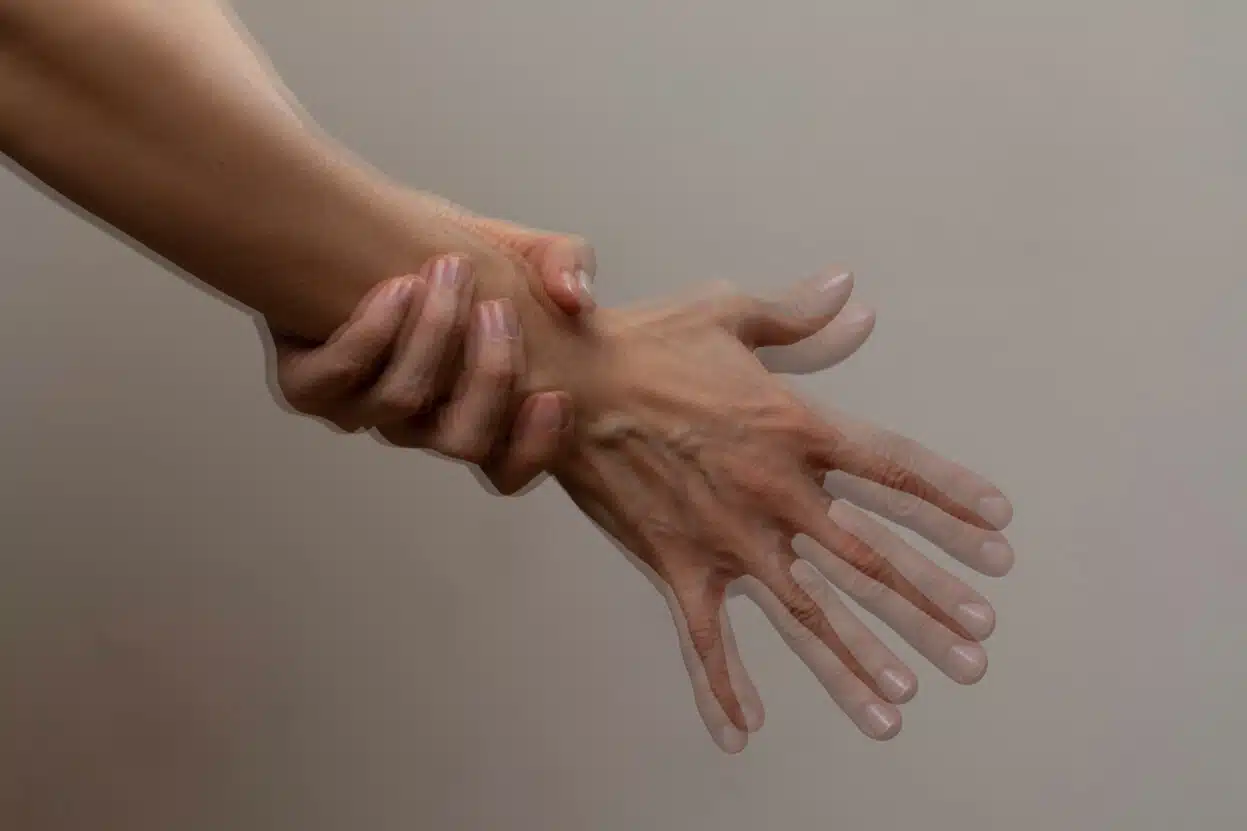Hands quivering uncontrollably while trying to drink your morning coffee, fingers trembling when you reach for the phone, shaky hands making it tough to button your shirt… These frustrating symptoms could stem from one of two common neurological movement disorders – essential tremor or intention tremor.
While both conditions cause involuntary shaking of the hands, there are key distinctions between essential tremor vs intention tremor. In this blog post, we will outline the 10 key differences between these two types of tremors, including the causes, symptoms, affected areas and tests for diagnosis, so you can better understand each condition and find optimal intention tremor and essential tremor treatment.
Understanding Essential Tremor and Intention Tremor
Essential tremor and intention tremor are two neurological conditions that cause involuntary shaking or trembling of the hands, arms and sometimes other body parts. They have some overlapping symptoms which can make distinguishing between them a little tricky at times.
- Essential tremor causes shaking that is present at rest and worsens when trying to use the hands. It generally affects both sides of the body symmetrically.
- Intention tremor also causes shaking, but starts when a person voluntarily moves the hand towards an object or target. The shaking intensifies as the person gets closer to accomplishing the task.
Remember, while essential tremor is usually referred to as an ‘action tremor’, intention tremor is considered a ‘rest tremor’ since it surfaces during movement but not at rest.
Confusion between essential tremor and intention tremor sometimes occurs because essential tremor may initially appear during movement like intention tremor. However, close evaluation of symptoms and medical history provides clues to tell them apart.
Differentiating between these two conditions is important for finding the appropriate treatments to manage troublesome tremors. With support from healthcare professionals at Dementech, you can receive a quick and accurate diagnosis as well as an appropriate treatment plan. Get in touch here.
Diagnostic Challenges: Identifying Essential Tremor vs. Intention Tremor
Distinguishing essential tremors from intention tremors can be challenging at times owing to overlapping characteristics, and there being no definitive diagnostic tests or biomarkers to clearly differentiate the two conditions.
Our doctors conduct thorough neurological examinations to understand the likely tremor type underlying the patient’s symptoms, and will always ensure to have a detailed medical history of the patient to make any connections to other conditions.
Essential Tremor vs Intention Tremor: 10 Key Differences
Below, we outline some other useful ways to help differentiate between the two types of tremors.
1. Differentiating Symptoms: Essential Tremor vs. Intention Tremor
As previously mentioned, the main differentiating factor when it comes to symptoms is that essential tremor involves shaking when the affected muscle is at rest, in addition to posture and action. Intention tremor occurs only during purposeful, voluntary movements of the affected body part.
| Essential tremor | Intention tremor |
| Essential tremor most often affects the hands with bilateral symmetrical shaking, but can also cause tremor in the arms, head, voice, and legs in some patients. | Intention tremor is most prominent when using the hands for coordination tasks, and generally arises from one-sided neurological damage affecting one hand more noticeably. |
2. Tremor Characteristics: Rhythmic vs. Purposeful Movements
In addition to when the tremor occurs, the characteristic of the tremor itself can indicate essential tremor versus intention tremor.
| Essential tremor | Intention tremor |
| Essential tremor features a rhythmic, oscillating quality that is fairly regular back and forth shaking. | Intention tremor is different in that the shaking worsens progressively as the person voluntarily moves the limb closer to accomplishing a purposeful task. |
For example, intention tremor will cause increasing shaking of the arm and hand as the person reaches for a glass of water. The tremor intensifies with closer proximity to the target object. This distinguishes intention tremor from the rhythmic oscillation of essential tremor which does not change based on purposeful movement towards a target.
3. Timing and Triggering: Involuntary vs. Voluntary Actions
Essential tremor occurs involuntarily, without purpose or warning. The shaking can happen when the muscles are relaxed, when holding a sustained posture, or during movement. This differs from intention tremor which only arises during voluntary, purposeful motions that the person initiates intentionally.
4. Body Part Affected: Distinguishing Hand Tremors from Action Tremors
While hand tremors are the hallmark of both essential tremor and intention tremor, essential tremor, as mentioned, may also cause shaking in the arms, head, voice, trunk, and legs.
Intention tremor most distinctly involves the hands and arms during coordination tasks – and when it does affect other body parts, it is still triggered by purposeful voluntary movements.
Note that the body distribution can help differentiate intention tremor localised to the hands and arms from essential tremor which may be more widespread. However, isolated hand tremors can certainly occur in both conditions.
5. Posture-Related Variations: Essential Tremor vs. Intention Tremor
One key way to help distinguish essential tremor is that the shaking continues and may worsen when sustaining a passive posture. For example, when holding the arms extended outstretched, the tremors intensify compared to holding the arms relaxed at the sides. Intention tremor emerges only during actual movement of the limb. No tremor occurs when simply maintaining a passive posture.
6. Tremor Severity: Assessing Intensity and Impact on Daily Activities
Tremor severity helps assess disability but does not differentiate between essential and intention tremor. Accurately distinguishing the type requires examining the full clinical picture.
| Essential tremor | Intention tremor |
| The severity of essential tremor spans a wide spectrum, ranging from barely noticeable shaking to pronounced tremor that severely impacts functions like writing, drinking from cups, and eating. More severe essential tremor can greatly limit a person’s ability to perform daily tasks. | Intention tremor is graded based on the degree it impairs coordination during purposeful, volitional movement. Mild intention tremor may cause some difficulty while severe intention tremor can completely prevent normal control of arm and hand motion. |
7. Underlying Mechanisms: Neurological Basis of Essential vs. Intention Tremor
Gaining insight into the neurological origins of essential and intention tremor can also help healthcare professionals to differentiate the two conditions.
| Essential tremor | Intention tremor |
| Essential tremor likely relates to abnormal oscillations in the cerebellum and thalamus which distorts the brain’s internal signalling that controls coordinated muscle contraction and relaxation. | Intention tremor more distinctly indicates dysfunction arising in the cerebellum, the brain region that directly controls voluntary motion. |
While still not fully proven, these suspected neurological underpinnings provide useful context as doctors evaluate patients. Our diagnostic process here at Dementech aims to pinpoint the tremor type likely causing the symptoms based on distribution, triggers, and medical history.
8. Onset and Progression: Differentiating the Course of Each Tremor Type
The speed of onset and disease course over time can provide helpful clues when it comes to intention tremor vs essential tremor.
| Essential tremor | Intention tremor |
| Essential tremor frequently starts very gradually over years. The mild shaking slowly worsens in amplitude and frequency throughout the person’s life. | Intention tremor often arises more suddenly following an acute neurological insult like stroke, tumour, or trauma. |
However, note that the onset and progression of essential tremor can be variable.
9. Response to Medications: Treatment Approaches for Essential and Intention Tremor
While medication effects do not definitively diagnose the tremor type, noticeable improvement of tremors with certain drugs supports identifying essential tremor, and lack of medication response is more consistent with intention tremor’s origins.
| Essential tremor | Intention tremor |
| Essential tremors may improve with medications like the beta blocker propranolol or anti-seizure drugs such as primidone. | Intention tremor treatment focuses more heavily on rehabilitation strategies and addressing the underlying neurological condition causing the symptoms. |
10. Association with Other Conditions: Coexistence and Differential Diagnosis
In some cases, essential tremor and intention tremor may coexist with or appear similar to other medical conditions, leading to diagnostic complexity.
| Essential tremor | Intention tremor |
| Essential tremor frequently occurs alongside physiological tremor which can be caused by anxiety, and may also be confused with enhanced physiological tremor, dystonic tremor, or Parkinsonian tremor. | Intention tremor can result from various neurological disorders including stroke, multiple sclerosis, tumours, trauma, or neurodegeneration. Intention tremor must also be differentiated from tremors caused by drugs, metabolic disorders, or psychogenic causes. |
You can find more information about different types of tremors here.
As part of your assessment, healthcare professionals will rule out alternative causes of tremors, and identify all coexisting conditions to optimise treatment.
Note that associated conditions like arthritis, thyroid disorders, anxiety, and peripheral neuropathy may exacerbate tremor severity.
Specialised Tremor Treatment Services
Here at Dementech Neurosciences, we have extensive experience evaluating and treating all forms of tremor through an individualised, patient-centred approach. Our team of neurologists conducts thorough clinical assessments and cutting-edge diagnostic testing to determine if you or your loved one is experiencing essential tremor, intention tremor, or another tremor disorder.
There are many options available to reduce tremor and improve quality of life, from medications and botulinum toxin to surgery and lifestyle changes we might recommend. Our compassionate doctors are here to partner with you through every step of the diagnosis and treatment process.
If you are struggling with tremors that interfere with your daily activities, we encourage you to visit our website or call us on 020 3666 1122 to book an appointment.
FAQs: Essential Tremor vs Intention Tremor
How does the brain-muscle connection play a role in essential tremor and intention tremor?
Both essential tremor and intention tremor relate to a breakdown in the brain’s ability to regulate coordinated muscle contractions. Essential tremor may stem from faulty oscillations between the cerebellum and thalamus, while intention tremor points to cerebellar damage. This leads to tremors when the brain signals cause undesired alternating muscle tightening and relaxation. Understanding how the neurological signalling misfires helps explain the involuntary tremors.
How do I distinguish essential tremor and intention tremor from other related conditions?
There are a number of conditions that are often confused or incorrectly linked with essential and intention tremors.
- Tourette syndrome causes different types of involuntary motor and vocal tics.
- Temporal arteritis is an inflammation of arteries in the scalp that causes headache and flu-like symptoms.
- Blepharospasm is involuntary eyelid muscle contractions causing eyelids to close forcefully.
- Giant cell arteritis involves inflammation of blood vessels that may cause double vision.
These conditions do not directly produce hand / arm tremors. If intention tremor from neurological damage did affect ocular muscles, it would cause shaking of the eyes rather than forceful spasms or blurred vision.
- Mini-strokes, Bell’s palsy, and retinal artery occlusions can sometimes cause intention tremor by damaging parts of the brain or nerves controlling coordinated movement.
- Thrombosis refers to blood clots that can lead to stroke.
Essential tremor and intention tremor are movement disorders, while the others represent vascular events, nerve damage or underlying medical conditions that may potentially contribute to intention tremor.
- Glaucoma relates to damage of the optic nerve, which would not directly cause tremors.
- Focal dystonia can cause isolated shaking of the hands or head but these tremors would not have the distinguishing features of essential or intention tremor.
- Arteritis refers to inflammation of arteries which could potentially lead to neurological damage and intention tremor.
- Myasthenia gravis affects communication between nerves and muscles, causing weakness, not typically tremor.
Is there a connection between diabetes and tremor in essential tremor vs. intention tremor?
There is no direct link between diabetes and essential tremor or intention tremor. However, poorly controlled diabetes can cause neurological complications which in turn could potentially contribute to intention tremor from cerebellar damage.





